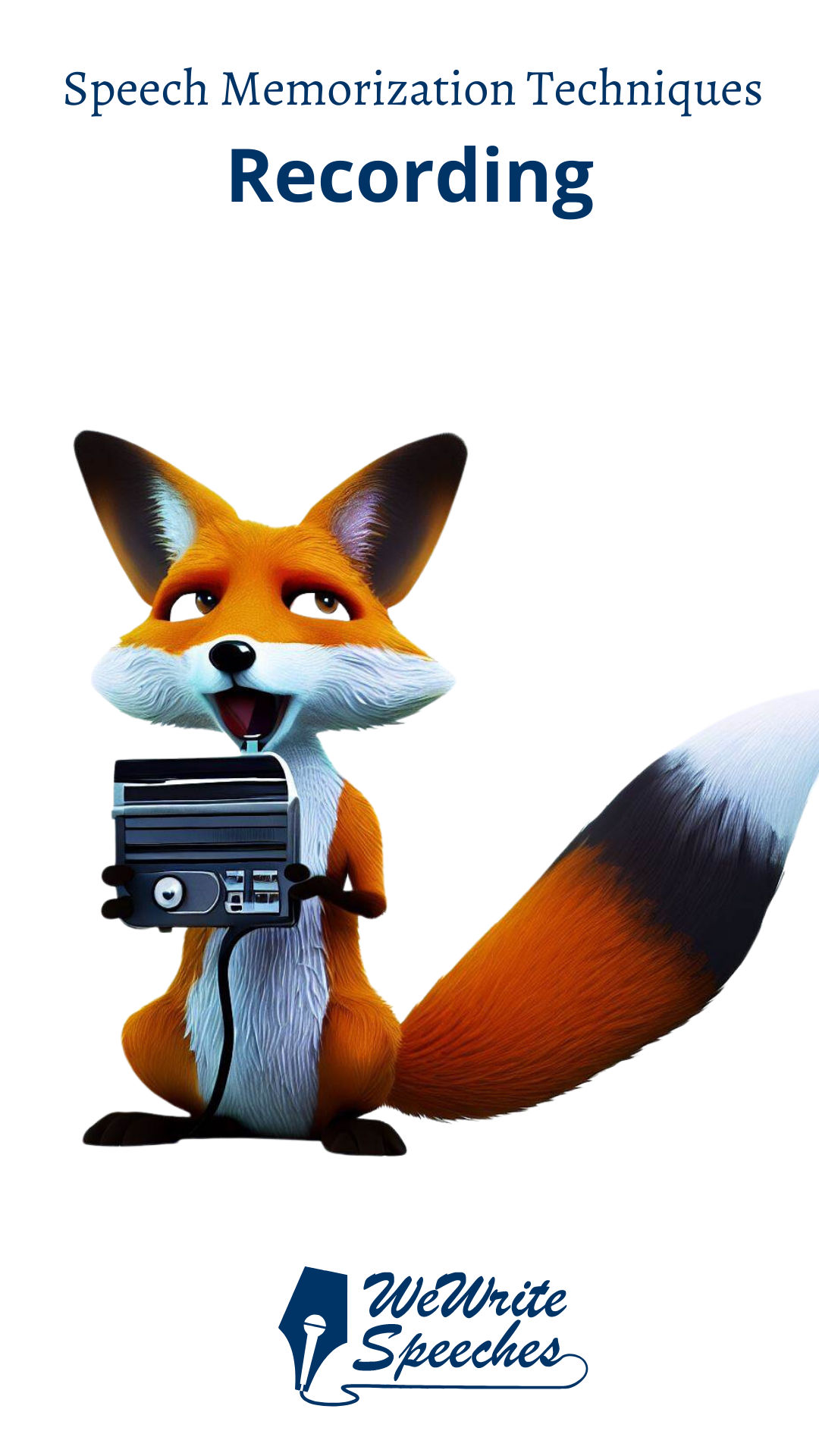Introduction
Are you facing the daunting task of delivering a speech? Do you find it challenging to remember your lines and convey your message effectively? Look no further! In this series, we will explore 13 speech memorization techniques that can empower you to remember your speech and then deliver it with confidence and precision. From chunking to the memory palace (loci) method, we'll delve into each technique, offering you valuable insights on how to enhance your speech memorization abilities.
You don't need to master all the techniques we present here; just find the mix of techniques that work best for you.
 Chunking involves breaking down your speech into smaller, manageable sections or "chunks." By dividing your speech into meaningful units, you can facilitate the memorization process. Each chunk represents a distinct idea or concept, making it easier for your brain to process and retain the information. Remember to focus on one chunk at a time, gradually building a coherent narrative. Go to article
Chunking involves breaking down your speech into smaller, manageable sections or "chunks." By dividing your speech into meaningful units, you can facilitate the memorization process. Each chunk represents a distinct idea or concept, making it easier for your brain to process and retain the information. Remember to focus on one chunk at a time, gradually building a coherent narrative. Go to article
 Visualization is a powerful technique that taps into the visual processing abilities of our brain. By creating vivid mental images related to your speech, you engage multiple senses, enhancing memory retention. Visualize yourself delivering the speech with confidence, imagine the venue, and visualize key points or supporting visuals. This technique helps embed the content in your mind, making it easier to recall during your speech. Go to article
Visualization is a powerful technique that taps into the visual processing abilities of our brain. By creating vivid mental images related to your speech, you engage multiple senses, enhancing memory retention. Visualize yourself delivering the speech with confidence, imagine the venue, and visualize key points or supporting visuals. This technique helps embed the content in your mind, making it easier to recall during your speech. Go to article
 Writing your speech plays a crucial role in the memorization process. As you write, you actively engage with the content, reinforcing the neural connections in your brain. Use your own words and try to express your thoughts and ideas clearly. Additionally, the act of writing helps you identify any weak areas in your speech, allowing you to refine and strengthen them. Go to article
Writing your speech plays a crucial role in the memorization process. As you write, you actively engage with the content, reinforcing the neural connections in your brain. Use your own words and try to express your thoughts and ideas clearly. Additionally, the act of writing helps you identify any weak areas in your speech, allowing you to refine and strengthen them. Go to article
 Rehearsing is an essential step in speech preparation. By practicing your speech repeatedly, you become more familiar with the content and its flow. You can rehearse alone or in front of a mirror, observing your body language and gestures. Gradually reduce your reliance on notes, focusing on delivering your speech fluently and confidently. Go to article
Rehearsing is an essential step in speech preparation. By practicing your speech repeatedly, you become more familiar with the content and its flow. You can rehearse alone or in front of a mirror, observing your body language and gestures. Gradually reduce your reliance on notes, focusing on delivering your speech fluently and confidently. Go to article
 Post-it notes serve as effective memory aids. Write down key points or phrases on small sticky notes and place them in strategic locations. These visual cues can jog your memory during your speech, helping you recall important information. However, be mindful not to rely solely on the notes, as they should complement your memorization efforts rather than substitute them. Go to article
Post-it notes serve as effective memory aids. Write down key points or phrases on small sticky notes and place them in strategic locations. These visual cues can jog your memory during your speech, helping you recall important information. However, be mindful not to rely solely on the notes, as they should complement your memorization efforts rather than substitute them. Go to article
 Mind maps are visual representations of information, connecting different ideas and concepts through branching associations. Create a mind map of your speech, starting with the main topic at the center and branching out to subtopics and supporting details. This technique enhances comprehension and helps you visualize the relationships between various elements of your speech. Go to article
Mind maps are visual representations of information, connecting different ideas and concepts through branching associations. Create a mind map of your speech, starting with the main topic at the center and branching out to subtopics and supporting details. This technique enhances comprehension and helps you visualize the relationships between various elements of your speech. Go to article
 Recording yourself while practicing your speech is a valuable technique for self-assessment. By listening to the recordings, you can identify areas where you need improvement. Pay attention to your tone, pacing, and clarity of speech. Make adjustments accordingly to enhance your delivery and ensure your message resonates with your audience. Go to article
Recording yourself while practicing your speech is a valuable technique for self-assessment. By listening to the recordings, you can identify areas where you need improvement. Pay attention to your tone, pacing, and clarity of speech. Make adjustments accordingly to enhance your delivery and ensure your message resonates with your audience. Go to article
 Mnemonic devices are memory aids that use associations to help you remember information. For example, FANBOYS is a mnemonic device used to remember coordinating conjunctions: For, And, Nor, But, Or, Yet, So. Identify or create mnemonic devices that suit your speech content and incorporate them to facilitate memorization. These devices can be acronyms, rhymes, or other memorable patterns. Go to article
Mnemonic devices are memory aids that use associations to help you remember information. For example, FANBOYS is a mnemonic device used to remember coordinating conjunctions: For, And, Nor, But, Or, Yet, So. Identify or create mnemonic devices that suit your speech content and incorporate them to facilitate memorization. These devices can be acronyms, rhymes, or other memorable patterns. Go to article
 Gestures can add impact and reinforce your message. Incorporate purposeful gestures into your speech to create a visual representation of your ideas. For instance, if you're emphasizing a point, use a hand gesture or body movement to complement your words. By aligning your body language with your speech, you enhance memorization and engage your audience more effectively Go to article
Gestures can add impact and reinforce your message. Incorporate purposeful gestures into your speech to create a visual representation of your ideas. For instance, if you're emphasizing a point, use a hand gesture or body movement to complement your words. By aligning your body language with your speech, you enhance memorization and engage your audience more effectively Go to article
 The Loci Method, also known as the Memory Palace technique, involves associating key points of your speech with specific locations in your imagination. Imagine walking through a familiar place, such as your home, and assign each point to a specific room or area. During your speech, mentally revisit these locations to trigger your memory and retrieve the associated content. Go to article
The Loci Method, also known as the Memory Palace technique, involves associating key points of your speech with specific locations in your imagination. Imagine walking through a familiar place, such as your home, and assign each point to a specific room or area. During your speech, mentally revisit these locations to trigger your memory and retrieve the associated content. Go to article
 Storytelling is a powerful technique for capturing your audience's attention and making your speech memorable. Frame your speech as a narrative, using characters, plot, and emotions to convey your message effectively. Stories engage the human brain, making it easier for your audience to connect with and remember your speech. Go to article
Storytelling is a powerful technique for capturing your audience's attention and making your speech memorable. Frame your speech as a narrative, using characters, plot, and emotions to convey your message effectively. Stories engage the human brain, making it easier for your audience to connect with and remember your speech. Go to article
 Grouping points into familiar structures (such as AIDA, PPPP, MINTO or The Rule of Three) can help with memory, as our brains tend to remember things in patterns. It simplifies your content, makes it more memorable (for you and the audience), and enhances its impact. Go to article
Grouping points into familiar structures (such as AIDA, PPPP, MINTO or The Rule of Three) can help with memory, as our brains tend to remember things in patterns. It simplifies your content, makes it more memorable (for you and the audience), and enhances its impact. Go to article
 Change your speech from one format to another. Bullet points to flashcards, flashcards to post-it notes. When you reprocess your content, you are actively engaging with it, which aids in memory consolidation. You're also creating various visual and cognitive 'anchors' that can prompt your memory when delivering your speech. These anchors can trigger a chain of thought that can help you recall large segments of your speech. Go to article
Change your speech from one format to another. Bullet points to flashcards, flashcards to post-it notes. When you reprocess your content, you are actively engaging with it, which aids in memory consolidation. You're also creating various visual and cognitive 'anchors' that can prompt your memory when delivering your speech. These anchors can trigger a chain of thought that can help you recall large segments of your speech. Go to article
Conclusion
In conclusion, delivering a memorable speech requires effective memorization techniques. By employing strategies such as chunking, visualization, rehearsal and the others mentioned in the series, you can enhance your ability to remember and deliver your speech confidently. Remember, practice and persistence are key to mastering these techniques. If you need expert assistance in preparing your speech, consider reaching out to WeWriteSpeeches. Our team of professional speechwriters can provide valuable guidance and support, ensuring your speech resonates with your audience and leaves a lasting impact.
Frequently Asked Questions
1. How long does it take to memorize a speech? The time required to memorize a speech varies depending on its length and complexity. However, with consistent practice and the implementation of effective memorization techniques, you can significantly reduce the time needed for memorization.
2. Can these techniques be applied to any type of speech? Yes, these techniques are versatile and can be applied to various types of speeches, including presentations, public speeches, or formal addresses.
3. Can I combine multiple techniques for better results? Absolutely! It is the best way. Combining different techniques can synergistically boost your memorization and delivery. Experiment with various approaches to find the combination that works best for you.
4. How can WeWriteSpeeches assist me in preparing my speech? WeWriteSpeeches offers professional speechwriting services as well as a self-service tool designed to help with wedding speeches in particular (at present). Our team of expert speechwriters can help you craft a compelling and impactful speech tailored to your specific needs and audience.




